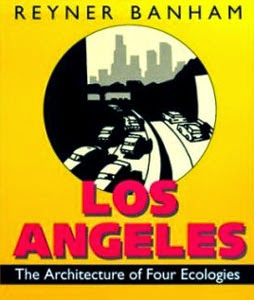Book Review: Los Angeles: The Architecture of Four Ecologies
Los Angeles: The Architecture of Four Ecologies by Reyner Banham, published by University of California Press, 2001. Paperback, 275 pages. (Amazon)

The four ecologies that Banham refers to in the title of his "light-hearted and affectionate tribute to Los Angles" (New York Review of Books) are the beach (what he calls Surfurbia), the foothills, the plains, and the freeways. This last part is definitely an attraction for the author who famously proclaimed, "like...English intellectuals who taught themselves Italian in order to read Dante in the original, I learned to drive in order to read Los Angeles in the original." But Banham doesn't rest on any conviction that the automobile created and defined the sprawling, centerless metropolis; rather he concludes that the Pacific Electric Railway laid the groundwork, the automobile merely following its lead (sometimes literally on top or next to old tracks). Along the way he investigates not only buildings by famous architects like Frank Lloyd Wright, R. M. Schindler, and Richard Neutra, but the infrastructure of the place and the "throw-away architecture" of restaurants, shopping malls, and the like. Published in 1971, this book was one of the first to take a serious look at LA's built environment in its totality, giving it credit where others were apt to dismiss it. This highly enjoyable read proves that Banham ranks as one of the best architecture critics in history, not only for his fresh and readable prose but for his broad definition and coverage of architecture and the urban landscape.

The four ecologies that Banham refers to in the title of his "light-hearted and affectionate tribute to Los Angles" (New York Review of Books) are the beach (what he calls Surfurbia), the foothills, the plains, and the freeways. This last part is definitely an attraction for the author who famously proclaimed, "like...English intellectuals who taught themselves Italian in order to read Dante in the original, I learned to drive in order to read Los Angeles in the original." But Banham doesn't rest on any conviction that the automobile created and defined the sprawling, centerless metropolis; rather he concludes that the Pacific Electric Railway laid the groundwork, the automobile merely following its lead (sometimes literally on top or next to old tracks). Along the way he investigates not only buildings by famous architects like Frank Lloyd Wright, R. M. Schindler, and Richard Neutra, but the infrastructure of the place and the "throw-away architecture" of restaurants, shopping malls, and the like. Published in 1971, this book was one of the first to take a serious look at LA's built environment in its totality, giving it credit where others were apt to dismiss it. This highly enjoyable read proves that Banham ranks as one of the best architecture critics in history, not only for his fresh and readable prose but for his broad definition and coverage of architecture and the urban landscape.
Comments
Post a Comment
Comments are moderated for spam.